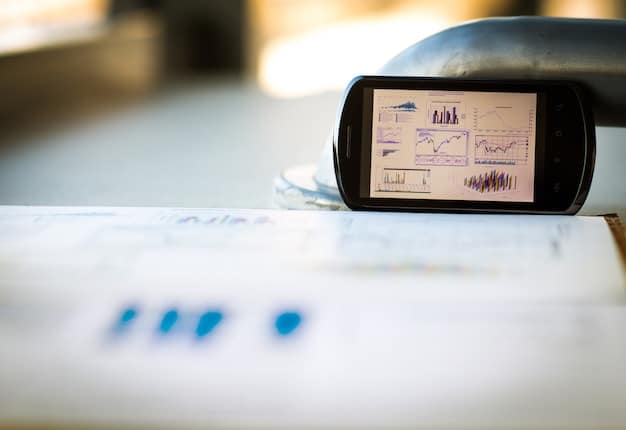AI Traffic Management: Cutting Congestion by 15% in US Cities

AI-Powered Traffic Management is revolutionizing urban transportation by using advanced algorithms to optimize traffic flow, predict congestion, and dynamically adjust traffic signals, leading to a significant 15% reduction in congestion across major US corridors.
Imagine a city where traffic flows smoothly, commutes are shorter, and the stress of gridlock is significantly reduced. This vision is becoming a reality thanks to AI-Powered Traffic Management: Reducing Congestion by 15% in Major US Corridors.
The Rise of AI in Traffic Management
Artificial intelligence is no longer a futuristic concept; it’s a present-day solution transforming various industries, including transportation. AI-powered traffic management systems are emerging as a powerful tool to address the growing challenges of urban congestion.
These systems leverage machine learning, data analytics, and real-time sensor data to optimize traffic flow, improve safety, and reduce travel times. By intelligently managing traffic signals, predicting congestion, and providing adaptive routing, AI is paving the way for smarter and more efficient transportation networks.
How AI is Changing Traffic Patterns
Traditional traffic management systems rely on fixed schedules and reactive adjustments. AI-powered systems, on the other hand, use predictive algorithms to anticipate traffic patterns and proactively optimize signal timings.
This dynamic approach allows for real-time adjustments based on current traffic conditions, leading to smoother traffic flow and reduced congestion. AI algorithms analyze vast amounts of data from various sources, including traffic cameras, sensors, and GPS data from vehicles, to make informed decisions and improve overall traffic efficiency.
- Predictive Modeling: Using historical and real-time data to forecast traffic patterns.
- Adaptive Signal Control: Adjusting traffic signal timings in real-time to optimize flow.
- Incident Detection: Identifying and responding to accidents and other traffic incidents quickly.
The integration of AI in traffic management has shown promising results, including reduced commute times, decreased fuel consumption, and improved air quality. Cities across the US are increasingly adopting these technologies to address their unique traffic challenges and create more sustainable urban environments.

Real-World Impact: 15% Congestion Reduction
The implementation of AI-powered traffic management systems is not just theoretical; it’s delivering tangible results in major US corridors. Studies have shown a significant reduction in congestion, with some cities reporting a 15% decrease in traffic delays.
This translates to real-world benefits for commuters, businesses, and the environment. Reduced congestion means shorter travel times, lower fuel consumption, and decreased emissions, contributing to a more sustainable and livable urban environment.
Case Studies: Success Stories from Across the US
Several US cities have emerged as leaders in adopting AI-powered traffic management systems. These cities serve as examples of how AI can effectively address traffic congestion and improve urban mobility.
By analyzing the successes and challenges of these early adopters, other cities can learn valuable lessons and implement similar solutions tailored to their specific needs. The focus on data driven desicions and adaptability are key components of success.
- New York City: Implementing AI to optimize traffic flow in Manhattan, reducing congestion during peak hours.
- Los Angeles: Using AI-powered predictive modeling to anticipate and mitigate traffic incidents.
- Atlanta: Deploying adaptive signal control systems to improve traffic flow on major corridors.
The positive impacts of AI-powered traffic management extend beyond reduced congestion. These systems also contribute to improved safety, reduced emissions, and enhanced quality of life for urban residents. As more cities adopt these technologies, the benefits are expected to become even more widespread.
Key Technologies Behind AI Traffic Management
The effectiveness of AI-powered traffic management relies on a combination of advanced technologies working together seamlessly. Machine learning algorithms, real-time data analytics, and smart sensors are the core components of these systems.
Understanding the underlying technologies is crucial to appreciating the potential and limitations of AI in traffic management. This section delves into the key technologies that enable AI-powered traffic optimization.
Deep learning techniques are improving traffic flow through constant analysis. The application of these methodologies allows for refined adjustments based on specific factors.
Deep Learning Algorithms
Deep learning, a subset of machine learning, plays a crucial role in analyzing traffic data and predicting congestion patterns. Deep learning algorithms are capable of processing vast amounts of data and identifying complex relationships that would be difficult for traditional systems to detect.
These algorithms can learn from historical traffic data, weather patterns, and event schedules to predict future traffic conditions and optimize traffic signal timings accordingly. It is important to understand how these models work, as well as the data inputs to make smart decisions.
Real-Time Data Analytics
The ability to process and analyze data in real-time is essential for effective traffic management. AI-powered systems utilize real-time data from various sources, including traffic cameras, sensors, and GPS data from vehicles, to monitor traffic conditions and identify potential bottlenecks.
This real-time data is then fed into AI algorithms, which analyze the information and make recommendations for optimizing traffic flow. The continuous monitoring of road networks ensures optimal traffic management.
Smart Sensors and IoT Devices
Smart sensors and Internet of Things (IoT) devices provide the raw data that fuels AI-powered traffic management systems. These sensors can collect data on vehicle speed, traffic volume, and road conditions, providing a comprehensive view of the traffic environment.

IoT devices, such as connected vehicles and traffic lights, can also contribute data to the system, further enhancing its ability to monitor and manage traffic flow. The data aggregation and analysis is vital to ensure positive performance.
Challenges and Considerations for AI Implementation
While AI-powered traffic management offers significant potential, it also presents certain challenges and considerations. Data privacy, security risks, and ethical concerns must be addressed to ensure responsible and equitable implementation.
Furthermore, the cost of implementing and maintaining these systems can be a barrier for some cities. Addressing these challenges is crucial to realizing the full potential of AI in traffic management.
Data Privacy and Security
AI-powered traffic management systems rely on collecting and analyzing vast amounts of data, raising concerns about data privacy and security. It is essential to implement robust security measures to protect data from unauthorized access and misuse.
Furthermore, cities must be transparent about how they are collecting and using data and provide individuals with the ability to control their data. Securitiy is an aspect not to be taken for granted, especially in AI implementation.
- Anonymization Techniques: Protecting individual privacy by removing identifying information from data.
- Data Encryption: Securing data transmissions and storage through encryption algorithms.
- Access Controls: Limiting access to data to authorized personnel only.
Ethical Implications and Bias Mitigation
AI algorithms can perpetuate existing biases if they are trained on biased data. It is important to carefully evaluate the data used to train AI algorithms and implement strategies to mitigate bias.
Furthermore, cities must consider the ethical implications of using AI to make decisions about traffic management and ensure that these decisions are fair and equitable for all members of the community. Removing bias is an ongoing task.
The Future of AI in Transportation
The integration of AI in transportation is only just beginning. As AI technology continues to evolve, we can expect to see even more innovative applications in the years to come. Self-driving vehicles, personalized transportation services, and smart infrastructure are just a few examples of the potential future of AI in transportation.
AI’s improvements have extended to supply chains, enhancing efficiency and transparency. This advancement benefits transportation networks due to its streamlined methodology and innovative capabilities.
Self-Driving Vehicles and AI Integration
Self-driving vehicles are heavily reliant on AI for perception, navigation, and decision-making. As self-driving technology matures, it will become increasingly integrated with AI-powered traffic management systems, creating a seamless and efficient transportation ecosystem.
AI can coordinate the movement of self-driving vehicles, optimize traffic flow, and reduce the risk of accidents. The implementation of vehicle to vehicle communication is vital for autonomous movement.
Personalized Transportation Services
AI can also be used to personalize transportation services, providing individuals with tailored travel options based on their needs and preferences. AI-powered ride-sharing apps can optimize routes, match riders with drivers, and provide real-time updates on travel times.
Furthermore, AI can be used to develop personalized public transportation schedules, ensuring that buses and trains are running when and where people need them. These AI solutions are vital for a more efficient future.
| Key Point | Brief Description |
|---|---|
| 🚦 AI Traffic Management | Reduces congestion by dynamically optimizing traffic flow. |
| 📊 Real-World Impact | US corridors experience a 15% decrease in traffic delays. |
| 🤖 Key Technologies | Deep learning, real-time data analytics, and smart sensors. |
| 🔒 Challenges | Data privacy, security risks, and ethical considerations. |
Frequently Asked Questions
▼
AI systems analyze real-time traffic data to dynamically adjust signal timings, reducing delays and improving flow based on current conditions.
▼
AI systems use data from traffic cameras, sensors, and GPS to monitor vehicle speed, density, and road conditions.
▼
AI systems can improve safety by detecting and responding to accidents faster than traditional systems, mitigating potential risks.
▼
Yes, AI algorithms consider weather and road conditions to proactively manage traffic, enhancing safety and workflow.
▼
AI optimizes routing and signal timings to minimize delays, decreasing travel times by up to 15% in congested areas.
Conclusion
AI-Powered Traffic Management is revolutionizing urban transportation by optimizing traffic flow and reducing congestion in major US corridors. By leveraging machine learning, real-time data analytics, and smart sensors, AI offers a path towards smarter, safer, and more sustainable urban environments.





